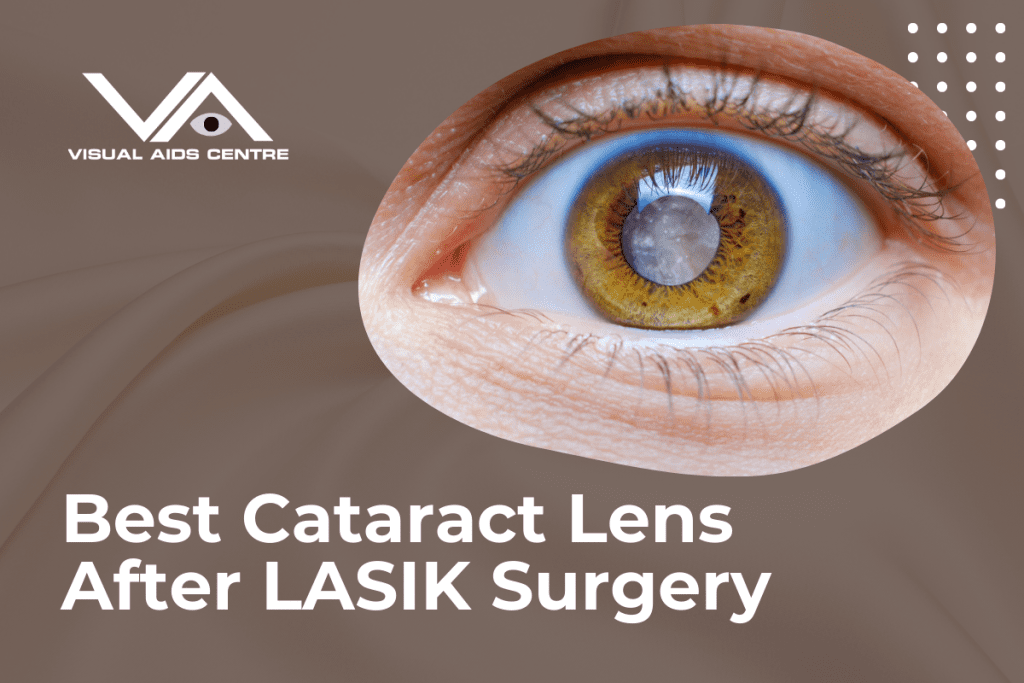Table of Contents
ToggleCataracts and LASIK are two of the most common eye procedures performed around the world. While LASIK is often a choice for improving visual acuity and reducing dependence on glasses, cataracts are an unavoidable age-related condition. Managing cataracts after LASIK surgery presents unique challenges, particularly when it comes to choosing the best intraocular lens (IOL) for cataract surgery.
In this article, we’ll explore those challenges and discuss the best options for IOLs following a LASIK procedure.

Understanding Cataracts and IOLs
Cataracts refer to a clouding of the eye’s natural lens, leading to blurred vision, glare, and challenges with night vision. The procedure for cataract surgery entails the extraction of the cloudy lens, which is then substituted with a transparent artificial lens known as an Intraocular Lens (IOL).
Understanding the Post-LASIK Eye
Before we jump into lens options, it’s essential to understand that an eye post-LASIK surgery sometimes behaves differently from an eye that has not undergone refractive surgery. LASIK alters the shape of the cornea, which can impact how light is focused onto the retina. This means that post-LASIK patients need carefully evaluated measurements to ensure the IOL power chosen delivers the best possible visual outcome.
Challenges in Lens Selection
The selection of an IOL after LASIK can be complex. Accurate IOL power calculation relies on the corneal curvature and the eye’s axial length; however, LASIK changes the cornea’s refractive power, which can skew traditional measurements and calculations that IOL implantation typically depends upon. An inaccurate power can lead to residual refractive errors, requiring glasses or additional procedures.
Option 1: Monofocal Lenses
Monofocal lenses are the most commonly implanted lenses during cataract surgery. These lenses offer one point of focus and are designed to provide clear vision at one specific distance. Patients can choose a lens power that will give them clear far vision (requiring glasses for near tasks) or vice versa.
For post-LASIK patients, monofocal lenses offer simplicity and a potentially safer option, as they do not involve complex calculations for multiple focal points.
Option 2: Multifocal Lenses
For those seeking greater independence from glasses, multifocal lenses may be an option. These lenses offer sharp vision across various distances. They are designed with concentric rings of different powers, and your pupil size and the lighting conditions determine which part of the lens you look through.
Post-LASIK patients considering multifocal lenses should discuss potential risks, like halos or glare, with their surgeon.
Option 3: Accommodative Lenses
These lenses are designed to move or change shape inside the eye, allowing for focusing at multiple distances. Accommodative IOLs potentially reduce the need for reading glasses.
Option 4: Toric Lenses
For patients with significant astigmatism after LASIK, toric IOLs might be the best option. These lenses are created to correct astigmatism and enhance overall visual quality. However, implanting a toric IOL requires very precise alignment, and the previous corneal changes from LASIK present additional challenges. Adjusting the lens to the correct axis is crucial to achieving the desired vision correction.
Option 5: Extended Depth of Focus (EDOF) Lenses
Extended depth of focus lenses are a newer option and are designed to provide a continuous range of vision from distance to intermediate tasks. These lenses might be preferable for post-LASIK patients who wish to reduce their dependence on glasses for activities like computer work.
The EDOF lenses minimize issues with glare and halos and provide crisp vision even in low-light conditions.
Navigating the Choices
The selection of the best lens after LASIK requires a detailed analysis of your pre-LASIK measurements, your current vision, any remaining refractive errors, your eye’s anatomical structure, and your lifestyle needs.
Modern technology, such as advanced ocular coherence tomography and wavefront scans, can assist surgeons in taking precise measurements for lens selection, even in eyes that have undergone LASIK.
Recommended Practices
Patients who have undergone LASIK and are now facing cataract surgery should consider the following practices:
- Consider your lifestyle, daily activities, and vision preferences. What ranges of vision are most critical for your quality of life?
- Seek out an ophthalmologist experienced in post-refractive surgery IOL calculations and implantation.
- Discuss with your doctor the potential risks and benefits of different lens options, especially in the context of your post-LASIK eyes.
- Ask about the outcomes of previous post-LASIK cataract surgeries your doctor has performed. Find out how satisfied other patients have been with similar lenses.
- Consider undergoing additional scans or tests that can help improve the accuracy of IOL power selection. Apart from standard IOL power formulas, additional testing such as topography and tomography of the cornea can be incredibly useful for post-LASIK eyes.
- It may take time to adapt to new lenses, and some fine-tuning might be necessary. Be prepared for a period of adjustment post-surgery.
Partnering for Clarity
The road to clear vision does not end with LASIK, and the appearance of cataracts later in life is a common roadblock. Selecting the best IOL after LASIK surgery is a nuanced process that requires a personalized approach. With careful planning and modern techniques, patients can achieve exemplary visual outcomes and enjoy a high quality of life even after their cataract surgery.
Remember, each patient’s eyes are unique, especially after LASIK, and thorough evaluation is essential. By staying informed and working closely with an experienced ophthalmologist, you can make the best decision for your vision needs.
Stay inquisitive, stay informed, and never hesitate to ask your healthcare provider questions regarding your eye health and surgical options.
Whether you’re a post-LASIK patient exploring your cataract surgery options or a wellness enthusiast keen on learning about the latest in ophthalmology, understanding the impact of LASIK on subsequent eye procedures is critical. Remember to consult with a trusted eye care professional when considering your choices for a cataract lens post-LASIK surgery. Your vision is invaluable; safeguard it with informed decisions and expert care.













